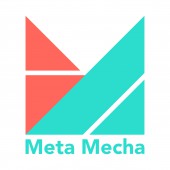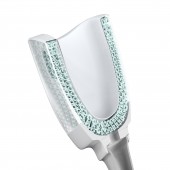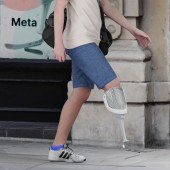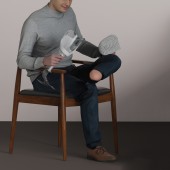DESIGN NAME:
Meta Mecha
PRIMARY FUNCTION:
Metamaterial Prosthetic Liner
INSPIRATION:
The future trend of computational design draws our attention to programmable matter and metamaterial. We are surprised to find its potential to empower design with material science and motivated to reconsider objects in microscopic logic.
With generative design and simulation tools, we propose application of metamaterial in the prosthetic field, offering both customized and medically compliant service.
UNIQUE PROPERTIES / PROJECT DESCRIPTION:
With 3D printable mechanical metamaterials as the prosthetic liner, Meta Mecha makes it possible to customize mechanical surfaces for different amputees according to personalized medical requirements.
The pressure sensitive color-changing material provides visualization of the unsuitability and draws attention.
The prosthetic liner can be replaced to support the deformation process of residual limb. The user can update their mechanical surface inside the prosthetic in a simple and economical way.
OPERATION / FLOW / INTERACTION:
Users first get residual limb 3D scanning and walk in a common socket to collect his pressure distribution data. A 3D model of metamaterial prosthetic liner is generated based on the data collected and medical requirements. After the prosthetic liner is 3D printed, it will be assembled with other parts of the prosthesis and delivered to the user. The prosthetic liner adjusts the best pressure level for the user and warns the user when pressure exceeds tolerance limits by color change. With the visual cue, the user can understand it's time to replace the liner to fit his residual limb deformation.
PROJECT DURATION AND LOCATION:
The project started in October 2021 in Shanghai, the first prototype was exhibited in D&I Shanghai in December 2021. An educational exhibition based on the project was shown in Shanghai Dyson Ideation Lab from February.
|
PRODUCTION / REALIZATION TECHNOLOGY:
The mechanical metamaterial prosthetic liner is 3D printed with industrial quality 3D printers and elastic TPU. It is impossible to manufacture the complex 3D shape without additive manufacturing technology.
3D scanning and pressure sensor equipment are used before the design process to acquire the shape and mechanical requirements of amputees.
Generative design approach is used to generate design with customized requirements. In our prototype, we use Grasshopper to generate our design.
SPECIFICATIONS / TECHNICAL PROPERTIES:
Width 136mm*Depth 139mm*Height 175mm
(The dimensions of prosthetic liner should differ from user to user, above is an example of our case)
TAGS:
Prosthetic socket liner, Customized design, 3D print, Computational design
RESEARCH ABSTRACT:
We had looked through papers on mechanical metamaterials, medical requirements on prosthetic and computational design to understand how to apply metamaterials in the prosthesis field. We then had conversations with a metamaterial specialist to verify our idea. We also printed out ten little blocks with metamaterial structure to experiment on different mechanical properties.
CHALLENGE:
It is a challenge for us to understand the logic and process of editing mechanical metamaterial. We have referred to many papers and interviewed a metamaterial specialist in our university and finally managed to arrange the structure unit on a prosthetic liner by using Grasshopper and plugins. Another challenge emerges when we try to prototype the product with 3D printing. It took us a while to find an industrial 3D printing laboratory that can use TPU to print the complex structure of metamaterial.
ADDED DATE:
2022-06-24 18:13:34
TEAM MEMBERS (4) :
Longyu Gong, Ruikun Pan, Xuerong Cai and Yanyun Wu
IMAGE CREDITS:
Images: Xuerong Cai, Ruikun Pan, Yanyun Wu, Longyu Gong
|










